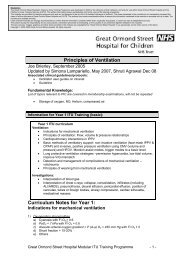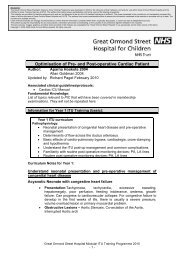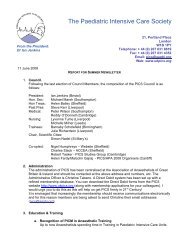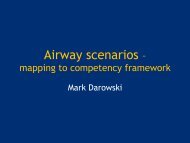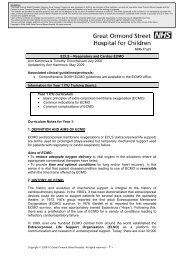Ventilation strategies for specific conditions - PICS
Ventilation strategies for specific conditions - PICS
Ventilation strategies for specific conditions - PICS
Create successful ePaper yourself
Turn your PDF publications into a flip-book with our unique Google optimized e-Paper software.
Disclaimer:<br />
The Great Ormond Street Paediatric Intensive Care Training Programme was developed in 2004 by the clinicians of that Institution, primarily <strong>for</strong> use within Great Ormond Street Hospital and the<br />
Children’s Acute Transport Service (CATS). The written in<strong>for</strong>mation (known as Modules) only <strong>for</strong>ms a part of the training programme.<br />
The modules are provided <strong>for</strong> teaching purposes only and are not designed to be any <strong>for</strong>m of standard reference or textbook. The views expressed in the modules do not necessarily represent the<br />
views of all the clinicians at Great Ormond Street Hospital and CATS. The authors have made considerable ef<strong>for</strong>ts to ensure the in<strong>for</strong>mation contained in the modules is accurate and up to date. The<br />
modules are updated annually.<br />
Users of these modules are strongly recommended to confirm that the in<strong>for</strong>mation contained within them, especially drug doses, is correct by way of independent sources.<br />
The authors accept no responsibility <strong>for</strong> any inaccuracies, in<strong>for</strong>mation perceived as misleading, or the success of any treatment regimen detailed in the modules.<br />
The text, pictures, images, graphics and other items provided in the modules are copyrighted by “Great Ormond Street Hospital” or as appropriate, by the other owners of the items.<br />
Copyright 2004-2005 Great Ormond Street Hospital. All rights reserved.<br />
<strong>Ventilation</strong> Strategies <strong>for</strong> Specific Conditions<br />
Author: David Inwald 2004,<br />
Updated: P. Ramnarayan Sept 05, D. Inwald Oct 06, S. Agrawal<br />
Jan 09<br />
Associated GOSH clinical guidelines/protocols:<br />
Detailed ventilator teaching packs by Lisa Martin, Senior ventilator technician.<br />
GOSH intranet > Guidelines & Projects > ICU Guidelines >IOL > teaching packs ><br />
Ventilator & respiratory systems support handouts.<br />
Asthma<br />
Bronchiolitis<br />
BAL<br />
PPHN protocol<br />
In<strong>for</strong>mation <strong>for</strong> Year 1 ITU Training (basic):<br />
Year 1 ITU curriculum<br />
Basic ITU management of the following Clinical Conditions:<br />
ALI & ARDS –basic management approach. Note patholophysiology covered<br />
in “respiratory physiology & pathophysiology” module<br />
Asthma & bronchiolitis<br />
Pneumonia, collapse & consolidation<br />
Pleural effusion, empyema and pneumothorax<br />
Note: Congenital mal<strong>for</strong>mations of the upper & lower airways are covered in<br />
“congenital mal<strong>for</strong>mations requiring surgery” module.<br />
Curriculum Notes <strong>for</strong> Year 1:<br />
The majority of children admitted to an intensive care unit are ventilated either <strong>for</strong> primary<br />
respiratory illnesses or <strong>for</strong> multi-system disorders such as sepsis, trauma and burns. With the<br />
increasing realisation that the act of ventilation may itself lead to organ failure, the adoption of<br />
an optimal ventilatory strategy <strong>for</strong> different <strong>conditions</strong> is important to achieve the best<br />
outcome with minimal risk.<br />
Acute lung injury (ALI)/ARDS<br />
Acute lung injury (ALI)/Acute respiratory distress syndrome (ARDS) are disorders marked by<br />
a significant inflammatory response to a local (pulmonary) or remote (systemic) insult<br />
resulting in injury to alveolar epithelial and endothelial barriers of the lung, acute inflammation<br />
and protein rich pulmonary oedema. ARDS is the more severe <strong>for</strong>m of ALI.<br />
Copyright 2004-5 Great Ormond Street Hospital. All rights reserved. Page 1 of 14
Great Ormond Street Hospital Modular ITU Training Programme 2008-2009<br />
Definition<br />
The most used definition <strong>for</strong> acute lung injury (ALI) and ARDS is the revised one from the<br />
1994 North American European Consensus Conference (NAECC). 1<br />
Bernard, G. R et al Am J Respir.Crit Care Med 149: 818-824.<br />
This is an example of a chest x-ray showing bilateral diffuse infiltrates:<br />
From http//www.ccmtutorials.com<br />
Incidence and aetiology<br />
ARDS in all age groups is reported to be relatively rare (75 cases/100,000 population per year<br />
based on the NAECC definition). The incidence of paediatric ARDS has not been studied in<br />
detail – reported rates based on the NAECC criteria vary from 8-16/1000 PICU admissions.<br />
A paediatric review from 2007 suggests a 9% occurrence of ALI in ventilated children out of<br />
which 80% progress to ARDS. The commonest etiology was found to be septicaemia<br />
(Dahlem et al. Pediatric acute lung injury. Paediatr Respir Rev. 2007 Dec;8(4):348-62)<br />
ALI/ARDS represent the end result of an aggressive inflammatory process in the lungs. The<br />
pulmonary response occurs to a broad range of injuries occurring either directly to the lungs<br />
or as a consequence of injury or inflammation at other sites in the body.<br />
Local insult<br />
Pneumonia<br />
Aspiration event<br />
Inhalational injury<br />
Fat/Air/Amniotic fluid embolism<br />
Radiation injury<br />
Systemic insult<br />
Sepsis<br />
Burns<br />
Major trauma<br />
Pancreatitis<br />
Poisoning<br />
Copyright 2008-9 Great Ormond Street Hospital. All rights reserved. Page 2 of 14
Great Ormond Street Hospital Modular ITU Training Programme 2008-2009<br />
Pathology<br />
Lung injury is a dynamic condition and the pathological features of ARDS are described as<br />
passing through three overlapping phases - an inflammatory or exudative phase (0-7 days), a<br />
proliferative phase (7-21 days) and lastly a fibrotic phase (from day 10).<br />
The chief pathological changes and clinical features are summarised below:<br />
<br />
<br />
<br />
<br />
<br />
<br />
<br />
<br />
<br />
Diffuse alveolar damage<br />
Proteinaceous and haemorrhagic interstitial oedema<br />
Hyaline membrane <strong>for</strong>mation<br />
Surfactant dysfunction<br />
Small airway collapse<br />
Reduced lung compliance<br />
V/Q mismatching<br />
Hypoxaemia<br />
‘Wet lungs’<br />
Therapeutic <strong>strategies</strong><br />
ARDS has no <strong>specific</strong> pharmacological treatment. Various support therapies have been<br />
studied; few of them have shown consistent benefit, perhaps due to the extremely<br />
heterogeneous nature of the disease.<br />
Summary of the various therapeutic <strong>strategies</strong><br />
Conventional mechanical ventilation<br />
Vasudevan A et al. Indian J Pediatr. 2004 Aug;71(8):743-50.<br />
The goal of ventilation in ARDS is to maintain adequate gas exchange with minimal ventilator<br />
induced lung injury (VILI).<br />
Mechanisms implicated in VILI<br />
Oxygen toxicity from use of high FiO2<br />
Over distension of alveoli leading to volutrauma and barotrauma<br />
Repetitive opening and closing of alveoli causing shear stress and triggering further<br />
inflammation (atelectrauma)<br />
Copyright 2008-9 Great Ormond Street Hospital. All rights reserved. Page 3 of 14
Great Ormond Street Hospital Modular ITU Training Programme 2008-2009<br />
The most revolutionary change in the management of children with ARDS has been adoption<br />
of the concept of "lung protective" ventilation where lower tidal volume (VT) and appropriate<br />
higher positive end-expiratory pressure (PEEP) are used. 2<br />
Key features of “lung protective” ventilation<br />
Controlled oxygen exposure<br />
Permissive hypercapnia<br />
Low tidal volumes 4-6 ml/kg<br />
Adequate PEEP<br />
Peak pressure < 30 cm H 2 O<br />
Controlled Oxygen Exposure<br />
High FiO2 should be avoided to minimise the risk of direct cellular toxicity and avoid reabsorption<br />
atelectasis. Even though there is no clinical evidence to suggest a threshold value,<br />
it is preferable to decrease FiO2 below 0.60 as soon as possible.<br />
Permissive hypercapnia<br />
Using the 'lung protective' strategy may cause hypercapnia. It is increasingly being accepted<br />
that a mild elevation of PaCO2 (permissive hypercapnia) and maintaining limits on VT and<br />
airway pressure is associated with a significantly lower mortality from ARDS. There are no<br />
data to confirm the degree of acidosis that is safe. It is probably safe to maintain a pH above<br />
7.25 with a PaCO2 of less than 10 kPa.<br />
Minimise Tidal Volume (VT)<br />
A couple of large studies have evaluated the role of lung-protective (low VT) strategy <strong>for</strong><br />
ARDS, which has shown an improved survival rate in patients with ARDS, although two other<br />
studies on patients with ARDS failed to show any benefit using low VT. Children with ARDS<br />
should be ventilated with a low VT of 6 ml/kg. If a child is ventilated on a pressure-controlled<br />
mode, tidal volumes should be accurately monitored.<br />
Note: Use of large tidal volumes even in patients without ARDS/ALI has shown to induce VILI<br />
and as a default, one should try and avoid tidal volumes above 8ml/kg in any pathology.<br />
Positive End-expiratory Pressure (PEEP)<br />
The application of adequate levels of PEEP improves oxygenation and is associated with<br />
favourable physiological outcomes. PEEP improves oxygenation by providing movement of<br />
fluid from the alveolar to interstitial space, recruitment of small airways and collapsed alveoli<br />
and an increase in functional residual capacity. In clinical practice, PEEP is adjusted between<br />
8 cm H 2 O and 20 cm H 2 O; PEEP is progressively increased by 2-3 cm H2O increments to<br />
maintain saturation between 90 and 95% with FiO2 < 0.5. The child should be monitored <strong>for</strong><br />
any evidence of cardiovascular compromise and hyperinflation.<br />
High frequency oscillatory ventilation (HFOV)<br />
There has been a resurgence of interest in HFOV over the last few years but the role in<br />
paediatric respiratory failure and ARDS remains a source of debate. The advantages of<br />
HFOV are (a) use of low VT and avoidance of barotrauma and (b) maintenance of near<br />
normal PaCO 2 with improved minute ventilation. Some studies in paediatric population have<br />
shown that early initiation of HFOV is associated with better oxygenation but none have<br />
demonstrated clearly improved outcome. 3<br />
Drugs<br />
<br />
<br />
<br />
Inhaled nitric oxide<br />
Surfactant therapy<br />
Corticosteroids<br />
Nitric Oxide (NO)<br />
NO causes pulmonary vasodilation and decrease in pulmonary hypertension. Maximal<br />
improvement in oxygenation is usually achieved with
Great Ormond Street Hospital Modular ITU Training Programme 2008-2009<br />
paediatric studies suggest that iNO improves short-term oxygenation in children with ARDS<br />
but little change is seen in long-term oxygenation indices. 4 Cochrane Metaanalysis from 2007<br />
doesnot show any added advantage of adding iNO in ARDS.<br />
Surfactant Therapy<br />
Few studies have shown improvement in oxygenation after using surfactant but there are no<br />
good randomized trials in paediatric ARDS to draw any definite conclusions. Surfactant may<br />
be a useful adjuvant in special situations when oxygenation cannot be achieved with<br />
conventional methods. The patients who would most benefit from this therapy remains to be<br />
elucidated.<br />
Corticosteroids<br />
The use of corticosteroid does not prevent the development of ARDS, nor is it beneficial when<br />
employed during the initial phase of the clinical course. However, in a prospective,<br />
randomized controlled trial prolonged administration of methylprednisolone in adult patients<br />
with unresolving ARDS (ARDS>7 days) was associated with improvement in lung injury and<br />
MODS scores and reduced mortality. 5 These findings have not been replicated in larger more<br />
recent RCTs, which have shown improved ventilatory parameters but increased late mortality<br />
in the group given steroids (see below (Year 2) <strong>for</strong> these papers).<br />
Prone positioning<br />
The mechanism of improvement in oxygenation with prone positioning is complex and varied.<br />
Changes in regional lung perfusion and in regional pleural pressures and recruitment of<br />
dorsal lung have been postulated to improve oxygenation during prone positioning. In a large<br />
study in adults, prone position was not associated with any improvement in clinical outcome.<br />
Prone positioning may be used in selected children with ARDS as it has few risks or cost<br />
involved.<br />
Asthma<br />
Asthma is characterised by reversible airway obstruction and inflammation. Intubation and<br />
ventilation are life saving in children with life-threatening features of severe asthma. Intubation<br />
can be associated with serious decompensation. Once intubated, the main <strong>strategies</strong><br />
applicable to the ventilation of patients with asthma are:<br />
Minimise minute ventilation<br />
Maximise time <strong>for</strong> expiration<br />
Slow rate, adequate inspiratory time (lower than physiologal rates)<br />
Avoid hyperinflation (air trapping)<br />
Accept lower pH (>7.2)<br />
Permissive hypercapnia<br />
Either Volume/pressure ventilation- maybe a marginal advantage of volume targeted<br />
with constant flow.<br />
In general, pressure controlled ventilation (keep PIP 1:2 and a slow rate allow emptying of the lungs and avoid ‘air trapping’ and<br />
progressive hyperinflation. Sometimes a manual decompression of chest helps to deflate<br />
overinflated lungs and improves ventilation.<br />
Sedation and neuromuscular paralysis are important to avoid the complications of air-leak.<br />
Preferred drugs <strong>for</strong> these patients are ketamine (has a bronchodilator effect) & fentanyl (as<br />
morphine causes histamine release which might aggravate bronchospasm). Suction and<br />
physiotherapy are important to clear mucus plugging and prevent atelectasis. Other <strong>specific</strong><br />
treatments <strong>for</strong> asthma in the <strong>for</strong>m of nebulised and intravenous salbutamol, intravenous<br />
aminophylline, systemic steroids and magnesium sulphate are important in the management<br />
of the intubated asthmatic.<br />
Copyright 2008-9 Great Ormond Street Hospital. All rights reserved. Page 5 of 14
Great Ormond Street Hospital Modular ITU Training Programme 2008-2009<br />
Bronchiolitis<br />
Bronchiolitis is a clinical syndrome of infancy characterised by respiratory distress and<br />
crepitations and wheezes on auscultation, due to inflammation of bronchiole mostly due to a<br />
viral infection. The main features are partial or complete airway obstruction, resultant<br />
atelectasis and a resultant V/Q mismatch.<br />
Infants can present predominantly with apneas, air trapping and wheeze, with atelectasis and<br />
parenchymal lung disease (ARDS) or a mixture of the above. The latter group are quite sick in<br />
the first 24 hours (AadO2 >400) and have a long ICU stay. Ventilatory <strong>strategies</strong> <strong>for</strong> each of<br />
the clinical presentations is different:<br />
<br />
<br />
<br />
Apnoeas (relatively normal lungs) – Minimise VILI with low Tv<br />
Air trapping – Manage like asthma<br />
ARDS – Manage like ARDS (including HFOV, iNO, ECMO)<br />
Co-infection with pertussis is common in infants who are partially or fully unimmunised (
Great Ormond Street Hospital Modular ITU Training Programme 2008-2009<br />
2. www.ccmtutorials.com - Excellent summary of adult ICU problems; Respiratory failure<br />
is covered well<br />
3. http://pedsccm.wustl.edu/FILE-CABINET/File_cab_index.html - Resources on the<br />
PedsCCM website dealing with Pulmonary topics<br />
References:<br />
Key articles attached<br />
1. Bernard, G. R., Artigas, A., Brigham, K. L., Carlet, J., Falke, K., Hudson, L., Lamy, M.,<br />
LeGall, J. R., Morris, A. and Spragg, R. (1994) The American-European Consensus<br />
Conference on ARDS. Definitions, mechanisms, relevant outcomes, and clinical trial<br />
coordination, Am J Respir.Crit Care Med 149: 818-824.<br />
2. Anon. (2000) <strong>Ventilation</strong> with lower tidal volumes as compared with traditional tidal<br />
volumes <strong>for</strong> acute lung injury and the acute respiratory distress syndrome. The Acute<br />
Respiratory Distress Syndrome Network, N.Engl.J Med 342: 1301-1308.<br />
3. Arnold JH, Hanson JH, Toro-Figuero LO, Gutierrez J, Berens RJ, Anglin DL.<br />
Prospective, randomized comparison of high-frequency oscillatory ventilation and<br />
conventional mechanical ventilation in pediatric respiratory failure.<br />
Crit Care Med. 1994;22:1530-9<br />
4. Taylor RW, Zimmerman JL, Dellinger RP, et al. Low-dose inhaled nitric oxide in<br />
patients with acute lung injury: a randomized controlled trial. JAMA. 2004 Apr<br />
7;291(13):1603-9.<br />
5. Meduri, G. U., Headley, A. S., Golden, E., Carson, S. J., Umberger, R. A., Kelso, T.<br />
and Tolley, E. A. (1998) Effect of prolonged methylprednisolone therapy in<br />
unresolving acute respiratory distress syndrome: a randomized controlled trial, JAMA<br />
280: 159-165<br />
Copyright 2008-9 Great Ormond Street Hospital. All rights reserved. Page 7 of 14
Great Ormond Street Hospital Modular ITU Training Programme 2008-2009<br />
In<strong>for</strong>mation <strong>for</strong> Year 2 ITU Training (advanced):<br />
Year 2 ITU curriculum<br />
More in-depth understanding of pathogenesis and aetiology of ALI and ARDS.<br />
Knowledge of current research.<br />
Pulmonary oedema, pulmonary haemorrhage<br />
Sickle chest syndrome<br />
Aspiration syndromes<br />
Cystic fibrosis<br />
Thoracic cage abnormalities.<br />
(Note: PPHN & meconium aspiration is covered in the Medical Neonates<br />
module; Heliox is covered in respiratory physiology & pathophysiology<br />
module)<br />
Curriculum Notes <strong>for</strong> Year 2:<br />
Further detailed in<strong>for</strong>mation on each of the <strong>conditions</strong> mentioned in the Year 1 curriculum<br />
notes is summarised below:<br />
Acute lung injury (ALI)/ARDS<br />
Epidemiology<br />
The largest proportion of ARDS cases are made up of children with sepsis, severe trauma,<br />
pneumonia and multiple transfusions of blood products. Overall, approximately 20-40% of<br />
patients with well-established risk factors and respiratory failure develop ARDS, and the more<br />
risk factors in any individual, the greater the likelihood of developing ARDS. There is evidence<br />
that certain genetic polymorphisms also influence the likelihood of developing and dying from<br />
ARDS (TNFA, surfactant protein B and ACE).<br />
Pathogenesis<br />
Lung injury is a dynamic process and passes through a series of three phases (day 0-7:<br />
exudative phase; day 7-21: proliferative phase; day 10 onwards: fibrotic phase).<br />
The key points in ARDS pathogenesis are:<br />
<br />
There is much greater overlap of the inflammatory and fibroproliferative phases of ARDS<br />
than previously imagined, with the fibroproliferative response beginning within 24 hours<br />
and its severity being directly related to the outcome.<br />
- Markers <strong>for</strong> collagen turnover are detectable in BAL fluid from 24 hours after<br />
ventilation <strong>for</strong> ARDS. Within 48 hours of diagnosis, myofibroblasts are detected in<br />
BAL fluid indicating early fibrotic mediators.<br />
<br />
An exaggerated inflammatory response underlies the pathogenesis of ARDS – the<br />
neutrophil is the dominant leucocyte, while many proinflammatory agents including<br />
endotoxin, proinflammatory and chemotactic cytokines, vascular endothelial growth factor,<br />
high mobility group-1 protein and thrombin, together with oxidant stress, are all implicated<br />
in vascular leakage and lung damage.<br />
- Neutrophils cause cell damage though the production of free radicals,<br />
inflammatory mediators, and proteases. Neutrophil elastase may be an important<br />
mediator of damage to the alveolar epithelium and the progression to fibrosis.<br />
- The inflammatory process is driven in part by cytokines including TNF- and IL-1ß,<br />
IL-6, and IL-8.<br />
<br />
Surfactant deficiency is not a primary causal event in ARDS; rather, the inflammatory<br />
processes lead to surfactant dysfunction as a secondary factor.<br />
Copyright 2008-9 Great Ormond Street Hospital. All rights reserved. Page 8 of 14
Great Ormond Street Hospital Modular ITU Training Programme 2008-2009<br />
<br />
Alveolar type II cell proliferation and enhanced fibroproliferation are key steps in attempts<br />
at repair in the lung; both offer potential targets <strong>for</strong> future therapies.<br />
Pathology and clinical implications<br />
Lung mechanics<br />
<br />
<br />
<br />
Lung involvement in ARDS is not homogenous<br />
Posterior, dependent portions of the lung are more severely affected, a distribution<br />
determined largely by gravity<br />
CT scans of ARDS survivors have shown greatest abnormality in the anterior parts of the<br />
lung even though the posterior areas had been most severely affected in the acute phase<br />
This is a CT chest in a patient with ARDS, showing the typical heterogeneous distribution of<br />
opacification within the lungs. The increased density of lung tissue in dorsal regions (A) is<br />
caused by consolidation and atelectasis. The aerated, ventral regions (B) have the highest<br />
compliance and tend to become overdistended (volutrauma). The interface between the two<br />
areas (C) is prone to cyclic recruitment–derecruitment (atelectrauma).<br />
Therapeutic <strong>strategies</strong> and ongoing research<br />
Moloney ED et al Br J Anaesth. 2004 Feb;92(2):261-70.<br />
Surfactant<br />
Although the use of surfactant has been tried on and off in ARDS, so far there has been no<br />
definite evidence of its benefit. However, a recent large multi-centre RCT showed that<br />
tracheal instillation of Calfactant resulted in a significant acute improvement in oxygenation<br />
and mortality, but did not suggest any significant decrease in the number of ventilator days,<br />
ICU stay or hospital length of stay. 1<br />
Prone positioning<br />
A number of uncontrolled studies showed improvement in oxygenation following prone<br />
positioning in children with ARDS. However, a recent large multicentre RCT in children did not<br />
suggest any differences at 28 days between the group that was positioned prone <strong>for</strong> 20<br />
hours/day <strong>for</strong> 7 days compared to the supine group. 2<br />
Ketoconazole<br />
Small studies suggested that ketoconazole had immunomodulatory properties that might be<br />
useful in ARDS. However, a large RCT co-ordinated by the ARDS Network did not show nay<br />
differences between the groups.<br />
Lisophylline<br />
Lisophylline was postulated as a drug that would dampen the pro-inflammatory mediators in<br />
ARDS; however, an RCT co-ordinated by the ARDS Network was stopped mid-way <strong>for</strong> futility.<br />
Copyright 2008-9 Great Ormond Street Hospital. All rights reserved. Page 9 of 14
Great Ormond Street Hospital Modular ITU Training Programme 2008-2009<br />
Steroids in late ARDS<br />
A recent adult RCT co-ordinated by the ARDS Network has just concluded and results have<br />
now been published 3 . Patients with ARDS of over 7 days in duration were randomised to<br />
receive 2mg/kg/d methylprednisolone (or placebo) <strong>for</strong> 14 days followed by a tapering dose<br />
over 11 days. Methylprednisolone increased the number of ventilator-free and shock-free<br />
days during the first 28 days in association with an improvement in oxygenation, respiratorysystem<br />
compliance, and blood pressure with fewer days of vasopressor therapy. As<br />
compared with placebo, methylprednisolone did not increase the rate of infectious<br />
complications but was associated with a higher rate of neuromuscular weakness. However,<br />
Methylprednisolone was associated with significantly increased 60- and 180-day mortality<br />
rates among patients enrolled at least 14 days after the onset of ARDS. These results do not<br />
support the routine use of steroids in ARDS.<br />
Fluid management<br />
A recent ARDSNet study involved randomising patients to a “fluid liberal” or “fluid restricted”<br />
strategy based on the use of central venous lines or pulmonary artery catheters. The results<br />
have now been published 4 . Although there was no significant difference in the primary<br />
outcome of 60-day mortality, conservative strategy of fluid management improved lung<br />
function and shortened the duration of mechanical ventilation and intensive care without<br />
increasing non pulmonary-organ failures.<br />
Immunonutrition<br />
Addition of glutamine, arginine and omega-3-fatty acids to diet has been suggested to<br />
promote immunomodulation. This therapy is unproven.<br />
Extra corporeal membrane oxygenation is reserved as a last resort.<br />
Pulmonary oedema and pulmonary haemorrhage<br />
Pulmonary oedema in children usually falls into one of three categories:<br />
<br />
<br />
<br />
<br />
Cardiogenic<br />
Negative pressure (post-obstructive)<br />
Neurogenic<br />
Non-cardiogenic<br />
Pulmonary haemorrhage is uncommon in children; severe coagulopathy and fluid overload<br />
are common causes. Unusual causes include tumours, Wegener’s granulomatosis, idiopathic<br />
haemosiderosis and aspergillosis (in the immunocompromised host – usually fatal).<br />
In both <strong>conditions</strong>, the main ventilatory <strong>strategies</strong> are:<br />
Conventional ventilation<br />
Minimise oxygen toxicity (FiO2
Great Ormond Street Hospital Modular ITU Training Programme 2008-2009<br />
Asthma and bronchiolitis<br />
The key to ventilate severe asthmatic is to achieve adequate oxygenation (sats 88-92%) and<br />
minimize hyperinflation by hypoventilating the patient (pH >/= 7.2). The main ventilatory<br />
<strong>strategies</strong> in these <strong>conditions</strong> are covered in Year 1 material. Novel adjunctive therapies are:<br />
<br />
<br />
<br />
Heliox (helium-O2 mixture) either be<strong>for</strong>e or during mechanical ventilation<br />
Aerosol delivery using heliox<br />
Inhaled or nebulised magnesium sulphate<br />
Use of heliox in the pre-ICU setting has received much attention – although there is lack of<br />
clear evidence based on the previous studies, it is likely to be useful in the sick asthmatic<br />
child in the first 24 hours. Use of heliox during mechanical ventilation has also resulted in<br />
dramatic improvement in respiratory acidosis in some case series. 5<br />
The use of extrinsic PEEP in the management is controversial and though some patients<br />
respond to extrinsic PEEP which matches the auto PEEP, others donot. The auto PEEP<br />
however could be monitored by measuring the end expiratory pressure. (Ref: Respir Care<br />
2008; 53: 740-748.)<br />
In very severe cases not responding to any of the above treatment stragtegies, buffer therapy<br />
with bicarbonate or THAM, inhaled anaesthetic gases, airway clearance with bronchoscopy &<br />
mucolytics, ECMO need to considered very very cautiously.<br />
Sickle chest syndrome<br />
Acute chest syndrome (ACS) in sickle cell disease is characterised by fever, infiltrates on<br />
chest radiograph, pleuritic chest pain, and hypoxaemia. ACS is the leading cause of<br />
hospitalisation in children with sickle cell disease; it is also associated with a 10-12% mortality<br />
rate and is the single most common cause of death in the >12 year old child with Hb SS.<br />
Clinical features<br />
Fever<br />
New (bilateral) infiltrates<br />
Pleuritic chest pain<br />
Hypoxaemia<br />
Leucocytosis<br />
Hypoxaemia may result from a number of pathological changes:<br />
Pathophysiology<br />
Microvascular occlusion (sickled RBCs and increased adhesion to vascular endothelium)<br />
Endothelial vasoactive mediator disturbance<br />
Release of inflammatory cytokines<br />
Activation of coagulation cascade system<br />
Fat embolism from bone marrow infarction<br />
Exaggerated regional hypoxic pulmonary vasoconstriction<br />
Copyright 2008-9 Great Ormond Street Hospital. All rights reserved. Page 11 of 14
Great Ormond Street Hospital Modular ITU Training Programme 2008-2009<br />
Ventilatory modalities:<br />
Conventional ventilation<br />
- ARDS type ventilation (low tidal volume, high PEEP, minimal O2)<br />
- Suction and physiotherapy<br />
- Use of N-acetyl cysteine, Dornase alpha<br />
- Bronchoscopy and lavage<br />
- Inhaled nitric oxide*<br />
High frequency oscillation<br />
- With or without nitric oxide*<br />
*As many as 60% adult patients with Hb SS are affected by pulmonary hypertension. Oral<br />
agents such as L arginine have been used. During ACS leading to ARDS, the successful use<br />
of iNO has been reported in case reports.<br />
Exchange transfusion is invaluable (usually double volume), although even a simple<br />
transfusion may increase the haemoglobin A2 sufficiently to dilute the level of HbSS.<br />
Antibiotics are normally prescribed to cover <strong>for</strong> atypical organisms. Data from a large cohort<br />
of ACS (adult and paediatric) suggests that infection is a common precipitating factor in ACS,<br />
although in the majority, the cause remains unknown. 6 Vichinsky EP et al. NEJM 2000;342:1855-65<br />
Pneumonia, lung collapse and aspiration syndromes<br />
The principles of ventilating a child with pneumonia or lung collapse/consolidation, aspiration<br />
syndromes, pulmonary oedema or pulmonary haemorrhage are similar to ARDS<br />
management. Pulmonary aspiration occurs commonly in children with neuromuscular<br />
weakness, cerebral palsy, or obtunded airway reflexes. Common causes <strong>for</strong> aspiration are:<br />
<br />
<br />
<br />
<br />
<br />
<br />
Accidental (<strong>for</strong>eign body aspiration)<br />
Gastro-oesophageal reflux<br />
Comatose patient<br />
During intubation (emergency)<br />
Cerebral palsy<br />
Bulbar weakness from neuromuscular disease (Guillain Barre syndrome)<br />
Copyright 2008-9 Great Ormond Street Hospital. All rights reserved. Page 12 of 14
Great Ormond Street Hospital Modular ITU Training Programme 2008-2009<br />
Summary of ventilation strategy:<br />
Minimise oxygen toxicity (FiO2
Great Ormond Street Hospital Modular ITU Training Programme 2008-2009<br />
2. Curley MA, Hibberd PL, Fineman LD, et al. Effect of prone positioning on clinical<br />
outcomes in children with acute lung injury: a randomized controlled trial. JAMA. 2005<br />
Jul 13;294(2):229-37.<br />
3. Steinberg KP, Hudson LD, Goodman RB et al. Efficacy and safety of corticosteroids<br />
<strong>for</strong> persistent acute respiratory distress syndrome. N Engl J Med. 2006;354:1671-84.<br />
4. Wiedemann HP, Wheeler AP, Bernard GR et al. Comparison of two fluidmanagement<br />
<strong>strategies</strong> in acute lung injury. ARDS Clinical Trials Network. N Engl J<br />
Med 2006;354:2564-75.<br />
5. Gupta VK, Cheifetz IM. Heliox administration in the pediatric intensive care unit: an<br />
evidence-based review. Pediatr Crit Care Med. 2005 Mar;6(2):204-11.<br />
6. Vichinsky EP, Neumayr LD, Earles AN, et al. Causes and outcomes of the acute<br />
chest syndrome in sickle cell disease. National Acute Chest Syndrome Study Group.<br />
N Engl J Med. 2000 Jun 22;342(25):1855-65.<br />
Copyright 2008-9 Great Ormond Street Hospital. All rights reserved. Page 14 of 14



